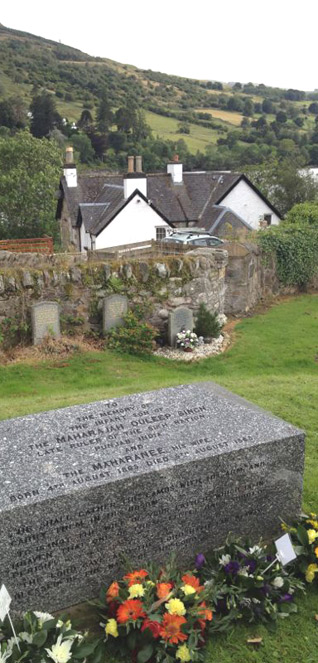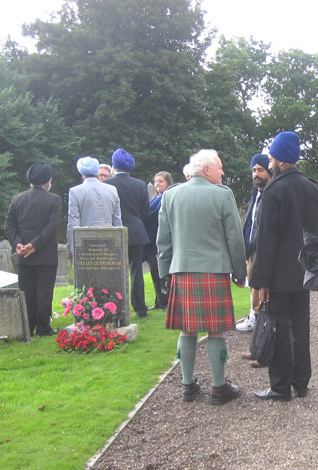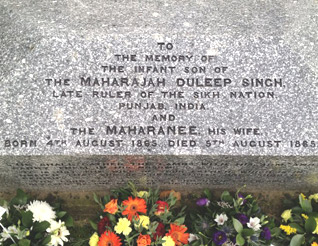History
The Nameless Prince of Perthshire
RANJIT SINGH SHAHI
In a wee hamlet tucked between the rolling hills and jagged peaks of the Scottish Highlands lies a small anonymous grave. In it rests a child who, were it not for his untimely demise, would have inherited South Asia’s greatest kingdom – the Kingdom of Punjab.
In 1865, the deposed King of the Sikhs, Maharaja Duleep Singh, buried his firstborn son, barely one day of age, in the churchyard of Kenmore, Perthshire.
This infant, who did not survive even long enough to be given a name, was the grandson of Punjab’s greatest lion, Ranjit Singh.
It was to this solemn place that I, along with many other adventurers, had the honour of travelling to yesterday (Friday, September 7, 2012).
Amongst our cortege was Bhupinder ‘Peter’ Singh Bance, an intrepid historian and biographer of Duleep Singh and his family, who regaled us with this extraordinary tale.
‘Following the fiercely fought Anglo-Sikh wars the Punjab was annexed by the British,’ we were told. ‘Duleep Singh, the young Emperor, was relocated to Scotland at the behest of the mentor appointed by his captors - Sir John Login. It was here in Scotland that he earned the moniker, ‘The Black Prince of Perthshire’ and, amongst other things, set a record for grouse shooting that is yet to be bested.’
Journeying through that rugged landscape - more akin to the setting of Braveheart, than the resting place of the heir to the great plains and rivers of Punjab - we arrived at the village of Kenmore flanking Loch Tay.
The fatigue of a 8-hour journey evaporated immediately upon arrival as we were warmly greeted by the locals - clan leaders, parishioners, ex-servicemen and school children. Amongst the throng, people craned their necks to get a glimpse of the grave – and the oblong marble stone above it that is inscribed with the words:
‘To the memory of the infant son of the Maharajah Duleep Singh, late ruler of the Sikh Nation, Punjab, India and the Maharanee, his wife. Born 4th August 1865. Died 5th August 1865.’
A service to mark the restoration of this site by the Anglo-Sikh Heritage Trail, Kenmore in Bloom and Kenmore Parish Church, began with an address by Rev. Ann Brennan of Kenmore Parish.
‘This here is the story of more than just a stone,’ she said. ‘For many years no one understood the significance of this site, but today we see the importance of this place to Sikhs and to Scots alike.’
Next, wreaths were laid by all, including James Rattray whose great grandfather raised the famous battalion of Sikhs to which he lent his name; the Sikhs of Scotland; and the school children of Kenmore.
Then, in keeping with Scottish tradition, a solitary bagpiper began a lament to this lost prince of the Sikhs. As the ethereal wail trailed off, a rousing jaikara reverberated through the village and a chorus of “Sat Sri Akaal” echoed in the hills that surrounded us.
Retiring to tea, Harbinder Singh of the Anglo-Sikh Heritage Trail talked of Anglo-Sikh relations which reflected the legacy of the tragic life of the Duleep Singh family, reading from a letter by the late Lt. Col Burridge, a former commander of Rattray’s Sikhs.
‘No race looked finer on parade than the Sikhs, and though raised in 1846 they, along with all Sikh battalions, stood firm during the Mutiny,’ the letter read, ‘and because of such greatness we were selected to be the guard of honour at the 1943 Tehran Conference in the presence of Churchill, Roosevelt and Stalin.’
Peter Bance then related to all assembled the narrative behind how the grave was re-found:
‘The Kenmore grave, lost to history for over a century, once again came to light in 1997. Having published a newspaper article on Duleep Singh, writer of 'The Maharaja’s Box’, Christy Campbell, received a response from a local Kenmore resident, Allan Walker. Allan claimed to know of a grave of a certain Duleep Singh. He sent us a picture of the grave and it looked familiar. I couldn’t put my finger on it though, until I was going through a Duleep Singh photo album I had acquired some time before. In this album was the original photo of the grave, taken around the time of the funeral. This discovery was of the utmost importance and rightly has put Kenmore on the world map, becoming the final resting place of the heir to Punjab.’
Councillor Sohan Singh of Glasgow also spoke of the grave and of the importance that such links have in creating cohesive communities.
‘This is as important for Scotland as it is for Sikhs. Such shared heritage is a way to foster greater links between all our communities, giving us the tools to work together to create a better society for all.’
I think it is appropriate to end with the words of Harbinder Singh who at the graveside had struck a deeply emotional chord by reading from the epilogue of Navtej Singh Sarna’s ‘The Exile’, a passage relating to the grave of Duleep Singh himself, which sits outside his palace, Elveden Hall, in England:
‘But there he lies, in a grave, in a cold wet land, far away from his people. Sometimes there is a flower on his grave, or even a fading bouquet. But mostly there are only brown fallen leaves that rustle in the wind.
‘And his memory will fade. His eight daughters and sons too are gone and not one of them left an heir. Perhaps this too was written. Or perhaps there was an imperial design. After all, it is known that Queen Victoria ordered the wife of Victor never to have children. Perhaps our Punjab was to be left only with the memory of a Maharaja-in-exile. Only with a story to be told around winter bonfires.’
‘Yet,’ said Harbinder Singh, as we stood amongst those silent hills, ‘here we are. This story has not yet been relegated to the annals of history. It is alive.’
September 8, 2012
Conversation about this article
1: N. Singh (Canada), September 08, 2012, 5:57 PM.
I cannot thank Harbinder Singh and ASHT enough for the work they have done. Having grown up in Britain, it is difficult to articulate how important it is for a child to be given a sense of pride in one's history beyond the exploits of the Sikh generals and shaheeds in India. This history takes us beyond 1849 and instills a sense of pride in our achievements despite having been defeated by the British. This history puts us on par with our past rulers (the British) and separates us from the slaves (the Indians).
2: Harmeet Singh (USA), September 08, 2012, 8:24 PM.
Had Sikhs buried their dead instead of cremating them, we would have preserved a long list of worthy monuments which would hark back to our history and heritage.
3: Gurpal Rai (Edinburgh, Scotland, United Kingdom), September 09, 2012, 4:00 AM.
I wanted to second the thoughts of N. Singh in the first post. Sadly I could not attend the ceremony last week but many non Sikhs at my work saw the press's overage and approached me to find out more about our history. Normally I am only asked about my turban and how long my hair is. It was refreshing to see people's amazement at learning that Sikhs had a kingdom. No matter what we may think, non-Sikhs do not visit our gurdwaras and when they do, they rarely learn about our history beyond 1699. ASHT fulfills this role and does so by proactively reaching out to non-Sikhs. Remarkable work.
4: Gurpreet Singh (Toronto, Ontario, Canada), September 09, 2012, 5:32 PM.
I agree, Harmeet Singh ji, and it would also allow us to visit our loved ones' graves if we followed that tradition. But I guess we will be defying our religious principles by doing so, no?
5: Harbinder Singh (United Kingdom), September 10, 2012, 4:47 AM.
Harmeet Singh and Gurpreet Singh ji - the issue of "promoting" gravestones is one which we regularly have to confront in our work. Sadly, it is a fact that due to his conversion the graves of the Duleep Singh family are all that remain of their presence in the UK. They are a moving and poignant reminder of our past and we are always amazed at the numbers of Sikh visitors that attend to pay their respect. For us the defining issue is that we do not promote them in any spiritual/ religious way. On the contrary we go to great pains to clarify that these are purely sites of cultural and historical "pilgrimage." Undoubtedly what they do is to invoke remembrance and reflection and that is to be encouraged.
6: Artika Bakshi (Sri Lanka), September 11, 2012, 12:30 AM.
It's really beautiful what the Anglo-Sikh trust is doing to showcase and preserve our heritage. Wish something like this could be done in India and Pakistan too. The summer place in Amritsar seems a bit neglected. Don't know the state of the monuments in Lahore.
7: H S Bhatia (Gurgaon, India), September 25, 2012, 6:06 AM.
It is somewhat surprising that all the eight offsprings of Maharaja Duleep Singh left no heirs. This needs more scrutiny to arrive at the correct status. Otherwise, my compliments to all concerned for refreshing a forgotten chapter in the glorious history of the Sikhs.






